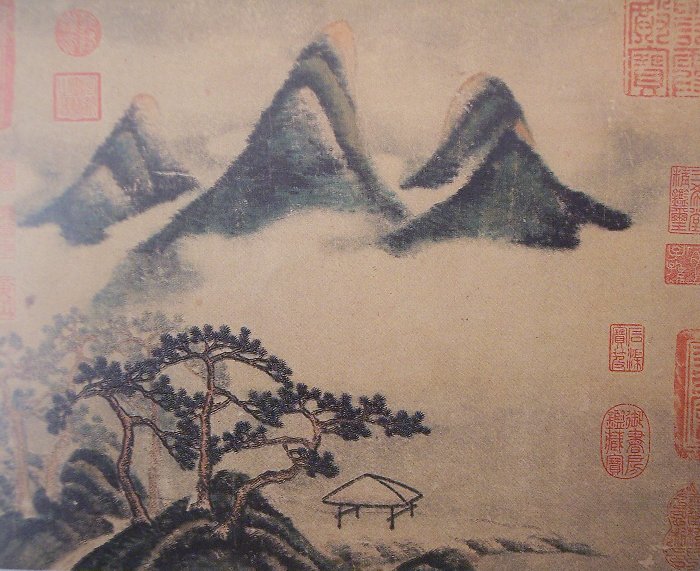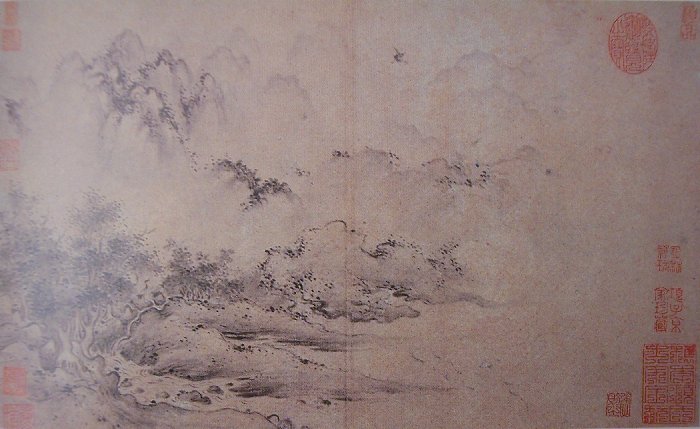|
Wild
Flowers and Black Rabbit (Anonymous)
|
Kitten (Anonymous)
|
Sung Dynasty (960 - 1179)
The
Sung Dynasty artists continued the traditions passed down from the Five
Dynasties Period, and in both the landscape art of the north – rugged, steep
and precipitous – and in the south – alluring, misty and elegant – scenes
were created in which one could travel, gaze, wander and dwell. In paintings of
the Sung Dynasty, one could find animals, birds, flowers and humans that were
not only accurately depicted in shape and manner, their internal substance,
emotions, ideas, and aspiration were also captured by the artists.
The Sung Dynasty can be seen as the highlight in the development of traditional Chinese painting. The main themes of Sung painting were landscape ( 山水 "mountains and rivers"), birds and flowers ( 花鳥 ) and the living nature such as bamboos, birds, insects, horses and other plants and animals, and figure painting ( 人物畫 ). The Sung Dynasty can be regarded the golden era of Chinese painting and pottery.
The Sung period painting was based on a development that already took place during the turbulent period of the Five Dynasties and Ten Kingdoms ( 五代十國 ) when countless painters renovated and refined the art. Those painters included Hsu Hsi ( 徐熙 ), Zhao Gan ( 趙幹 ), Wang Chi-Han ( 王齊翰 ), Zhou Wen-Ju ( 周文矩 ), Wei Xian ( 衛賢 ), Gu Hong-Zhong ( 顧閎中 ), Dong Yuan ( 董源 ), Guan Xiu ( 貫休 ), Huang Chuan ( 黃筌 ), Huang Ju-Bao ( 黃居寶 ), Huang Ju-Tsai ( 黃居寀 ), Jing Hao ( 荊浩 ), Gao Wen-Jin ( 高文進 ), Guan Tong ( 關仝 ), Lee Cheng ( 李成 ), and many others from the regions of the south and of Western Shu ( 西蜀, modern Sichuan Province).

Riding a Mule in the Winter Forrest by Lee Cheng
Many emperors at the beginning of the Sung Dynasty respected painters and calligraphers and invited them to become members of the Hanlin Calligraphy and Painting Academy ( 翰林書畫院 ). Emperor Sung Huizong (1082-1135) was a notorious monarch owing to his political incompetence and extravagances. On the other hand, he was famed for his inherence in arts as well as his contribution on the royal establishment of the Imperial Painting Academy which aimed at cultivating artisan-painters. However, the appraisals on this educational policy had two extreme divarications: literary artists blamed the limitation of painters' creativity on the realistic manner of the Imperial Painting Academy, where as those who supported the policy affirmed the merits of its existence, regarding it as a milestone of the development of Chinese art history. From historical point of view, the most important significance of the foundation of the Imperial Painting Academy was the reflection of the contemporary spirit of the society and philosophy.
The Hanlin Painting Academy ( 翰林圖畫院 ), also called the Imperial Painting Academy, was sponsored by the emperors themselves. Even painters from far away like Guo Zhong-Shu ( 郭忠恕 ) from the State of Zhou ( 後周 ) and the captured Wang Ai ( 王靄 ) followed the Sung emperor's invitation and came to the Sung capital Kaifeng ( 開封 ) where the Sung emperors personally admired and collected numerous paintings. Emperor Sung Taizong ( 宋太宗 ) even ordained famous masters to search for unknown painters among the populace of his realm to reward the best of them. The higher nobility, rich and influential, imitated the art patronage of the emperors and likewise collected paintings and sponsored painters. Their patronage contributed to the conservation of famous paintings from earlier periods of Chinese art history.
Sung Dynasty painting can be classified into four chronological periods.
The first period was characterized by realism ( 寫實主義 ) with many landscape paintings drawn out with meticulous and vigorous brushstrokes. Painters of this period included Lee Cheng, Fan Kuan ( 范寬 ) and Dong Yuan. Later in the 12th century, Yan Wen-Gui ( 燕文貴 ), Hsu Dao-Ning ( 許道寧 ), Gao Ke-Ming ( 高克明 ), Zhai Yuan-Shen ( 翟院深 ), Lee Zong-Cheng ( 李宗成 ) and Huang Huai-Yu ( 黃懷玉 ) took over this tradition, but at the same time animal and flower painting experienced a first highlight in the painting of Hsu Hsi, Hsu Chong-Si ( 徐崇嗣 ) and the two Huangs. Guo Xi ( 郭熙 ), Zhao Chang ( 趙昌 ), Tsui Bai ( 崔白 ), Wu Yuan-Yu ( 吳元瑜 ) and Yi Yuan-Ji ( 易元吉 ) perfected these styles with their pure and soft and refined beauty.
Magpies and Hare by Tsui Bai done in a realistic manner
![]()
Travelers by Streams & Mountains by Fan Kuan

Pavilions and Mansions by the River by Yan Wen-Gui
![]()
Heavy Snow on Mount Guan by Hsu Dao-Ning
![]()
Fisherman on a Mountain Stream by Hsu Dao-Ning

Stream in a Snow Scene by Gao Ke-Ming
|
A portrait of Sung Huizong
|
The age of Emperor Huizong ( 宋徽宗 ) was seen as the second period of Sung Dynasty painting. Huizong was a famous painter and calligrapher. He was the inventor of the famous Skinny Golden Style ( 瘦金體 ) of calligraphy. He even taught painting to many other prominent painters. Lee Tang ( 李唐 ), Su Han-Chen ( 蘇漢臣 ), Zhang Ze-Duan ( 張擇端 ), Liu Zong-Gu ( 劉宗古 ) and Huang Zong-Dao ( 黃宗道 ) were painters of this golden age of Sung painting. At the imperial court, Lee Gong-Lin ( 李公麟 ), Wang Shen ( 王詵 ), Zhao Ling-Rang ( 趙令穰 ), Mi Fu ( 米芾 ) and his son Mi You-Ren ( 米友仁 ) and Wang Hsi-Meng ( 王希孟 ) contributed to the perfection of the imperial court painting ( 宮廷繪畫 ) of the Sung Dynasty. |
|
|

Listening to the Qin by Emperor Sung Huizong

Birds by Emperor Sung Huizong

Children at Play in an Autumn Garden by Su Han-Chen
![]()
Wind Through the Pine Valleys by Lee Tang
Thousand Li of River and Mountains by Wang Hsi-Meng
Peace Reigns over the River (or Life Along the Bian River at the Pure Brightness Festival) by Zhang Ze-Duan, 24.8 x 528.7 cm
Snow over a Fishing Village by Wang Shen

Mountains and Pines in Spring by Mi Fu
After the retreat to the south, the emperors patronized private academies that were staffed with painters like Ma He-Zhi ( 馬和之 ), Liu Song-Nian ( 劉松年 ), Zhao Bo-Ju ( 趙伯駒 ), Mao Yi ( 毛益 ), the monk Fachang ( 法常 ), and Lee Song ( 李嵩 ).

Crane Calling Over A Clear Stream by Ma He-Zhi

Spring Mountains by Zhao Bo-Ju
The last period of Sung painting was characterized by the beautiful landscape paintings of the south, created by painters like Ma Yuan ( 馬遠 ), Xia Gui ( 夏珪 ), Liang Kai ( 梁楷 ), Ma Lin ( 馬麟 ), Lee Di ( 李迪 ) and Lu Zong-Gui ( 魯宗貴 ). Among the literati painters were further Yang Bu-Zhi ( 楊補之 ), Zheng Si-Xiao ( 鄭思肖 ), Zhao Meng-Jian ( 趙孟堅 ) and Gong Kai ( 龔開 ).

Mountain Path in Spring by Ma Yuan

Pure and Remote Views of Streams and Mountains by Xia Gui (partial)
Immortal in Splashed Ink by Liang Kai

Cowherds Fleeing A Storm by Lee Di
On the bustling markets of cities of the dynasty, less known painters among the populace that lived on painting sold their artworks to interested literate officials and wealthy merchants that contributed to the development of traditional Chinese Brush Painting. Some literate officials even started to paint themselves and produced a highly estimated genre of literati painting ( 文人畫 ) with representatives like Wen Tong ( 文同 ), Su Shi ( 蘇軾 ) and so on. Literati painting was conceived as a mode through which a noble person ( 君子 ) expressed his ethical personality. It was much less concerned with technical showiness. Literati painters specialized in plain ink paintings, sometimes with minimal color. They lay great emphasis on the idea that the style with which a painter controlled his brush conveyed the inner style of his character - brushstrokes were seen as expressions of the spirit more than the matters of composition or skill in realistic depiction.
|
Bamboo by Wen Tong Wen Tong ( 文同 ) loved painting bamboos. He planted bamboos around his house and observed how they grew in different seasons. Whenever he gained new understandings and insights, he would get the paper and ink ready to paint bamboos. Before he started painting, the images, temperament, and spiritual consonance of the bamboos were already created in his mind. Hence the famous Chinese saying "胸中有成竹 (literally having had the images of the bamboos ready in one's bosom)" which means having had ready plans or designs in one's mind before commencing a new task so that its success is guaranteed. He cast a strong influence on Lee Kan ( 李衎 ), another famous bamboo painter in the Yuan Dynasty.
|
|
Chen Rong ( 陳容 ) ca. 1200-1266 |
|
Dragons from "The Nine Dragons" handscroll ( 九龍圖卷 ), painted by Chen Rong in 1244.
|
(Back to History Menu) (Back to Home)